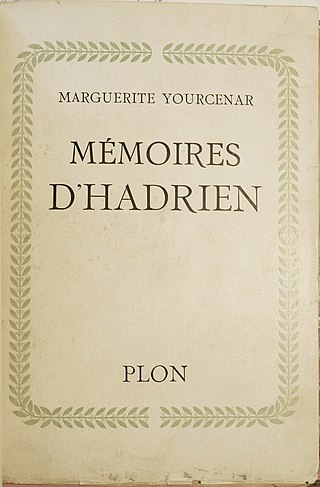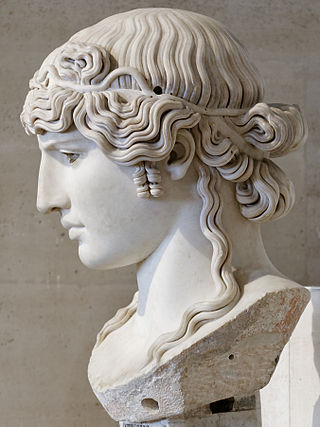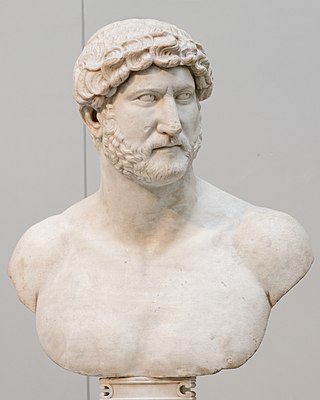
Hadrian was Roman emperor from 117 to 138. Hadrian was born in Italica, close to modern Seville in Spain, an Italic settlement in Hispania Baetica; his branch of the Aelia gens, the Aeli Hadriani, came from the town of Hadria in eastern Italy. He was a member of the Nerva-Antonine dynasty.

The 130s was a decade that ran from January 1, 130, to December 31, 139.
Year 130 (CXXX) was a common year starting on Saturday of the Julian calendar. At the time, it was known as the Year of the Consulship of Catullinus and Aper. The denomination 130 for this year has been used since the early medieval period, when the Anno Domini calendar era became the prevalent method in Europe for naming years.

Antinous, also called Antinoös, was a Greek youth from Bithynia and a favourite and lover of the Roman emperor Hadrian. Following his premature death before his 20th birthday, Antinous was deified on Hadrian's orders, being worshipped in both the Greek East and Latin West, sometimes as a god and sometimes merely as a hero.

Memoirs of Hadrian is a French-language novel by the Belgian-born writer Marguerite Yourcenar about the life and death of the Roman Emperor Hadrian. First published in France in 1951, the book was a critical and commercial success. It was translated into English by Grace Frick and published as Hadrian's Memoirs in 1954 by Farrar, Straus and Young and the following year in the UK as Memoirs of Hadrian. American editions of this translation are now published under the latter title.

Antinous is an obsolete constellation no longer in use by astronomers, having been merged into Aquila, which it bordered to the north.

Hadrian's Villa is a UNESCO World Heritage Site comprising the ruins and archaeological remains of a large villa complex built around AD 120 by Roman emperor Hadrian near Tivoli outside Rome.

The study of Roman sculpture is complicated by its relation to Greek sculpture. Many examples of even the most famous Greek sculptures, such as the Apollo Belvedere and Barberini Faun, are known only from Roman Imperial or Hellenistic "copies". At one time, this imitation was taken by art historians as indicating a narrowness of the Roman artistic imagination, but, in the late 20th century, Roman art began to be reevaluated on its own terms: some impressions of the nature of Greek sculpture may in fact be based on Roman artistry.

Antinoöpolis was a city founded at an older Egyptian village by the Roman emperor Hadrian to commemorate his deified young beloved, Antinoüs, on the east bank of the Nile, not far from the site in Upper Egypt where Antinoüs drowned in 130 AD. Antinoöpolis was a little to the south of the Egyptian village of Besa (Βῆσσα), named after the god and oracle of Bes. Antinoöpolis was built at the foot of the hill upon which Besa was seated. The city is located nearly opposite of Hermopolis Magna and was connected to Berenice Troglodytica by the Via Hadriana.

The Antinous Mondragone is a 0.95-metre high marble example of the Mondragone type of the deified Antinous. This colossal head was made sometime in the period between 130 AD to 138 AD and then is believed to have been rediscovered in the early 18th century, near the ruined Roman city, Tusculum. After its rediscovery, it was housed at the Villa Mondragone as a part of the Borghese collection, and in 1807, it was sold to Napoleon Bonaparte; it is now housed in the Louvre in Paris, France.

The Antinous Farnese is a marble sculptural representation of Antinous that was sculpted between 130 and 137 CE. Antinous was the lover to Roman Emperor Hadrian; the emperor who, after Antinous's death, perpetuated the image of Antinous as a Roman god within the Roman empire. This sculpture is a part of the Roman Imperial style and was sculpted during a revival of Greek culture, initiated by Hadrian's philhellenism. Its found spot and provenance are unknown, but this sculpture is currently a part of the Farnese Collection in the Naples National Archaeological Museum.
Antinous was the favorite and lover of Roman Emperor Hadrian.
Hadrian is an opera composed by American-Canadian singer-songwriter Rufus Wainwright, with a libretto by Daniel MacIvor, based on the life of Hadrian, Roman emperor from 117 to 138. First staged by the Canadian Opera Company, the opera premiered October 13, 2018, at the Four Seasons Centre in Toronto, directed by Peter Hinton.

The statue of Jupiter in the Hermitage Museum is a colossal sculpture of the supreme ancient god, created by an unknown Roman master at the end of the 1st century AD. He is one of the most famous exhibits of the museum. The statue of Jupiter is also a significant monument of the Flavian era, bearing the characteristic features of Roman art of this period. The prototype of this sculpture was created by Phidias in the 5th century BC, the legendary statue of Zeus at Olympia, revered as one of the Seven Wonders of the World. It was made for the temple of the supreme god - the central religious building of the Ancient Olympic Games. Found at the end of the 19th century in the Villa of Domitian, the statue of Jupiter ended up in the collection of the Marquis Giampietro Campana. After the ruin of the Marquis, the sculpture was bought by Emperor Alexander II and delivered to the Hermitage in 1861.

A bust of Hadrian, the second-century Roman emperor who rebuilt the Pantheon and constructed the Temple of Venus and Roma, was formerly displayed in Pope Sixtus V's Villa Montalto and is now displayed at the British Museum in London. The bust is one of the Townley Marbles collected by Charles Townley (1737–1805) and sold by his heir Peregrine Edward Towneley at a reduced price to the British Museum in 1805. Unlike most busts of Hadrian and other emperors, it shows him in heroic nudity. The bust was found in Rome and is carved from Greek marble.

The Townley Antinous is a marble portrait head of the Greek youth Antinous, the boyfriend or lover of the Roman Emperor Hadrian, wearing an ivy wreath. It is now part of the collection of London's British Museum, and was part of the Townley Marbles. Only the head is ancient, once belonging to statue dating from c. 130–140 and the late reign of Hadrian ; the bust is a modern addition. The portrait probably shows the youth as Dionysus–Bacchus. The bust was acquired along with the rest of the antiquities collected by 18th-century Grand Tourist and Fellow of the Royal Society, Charles Townley. A drawing of the bust attributed to Vincenzo Pacetti is also in the museum's collection.

The bust of Antinous in the White Hall of the Great Gatchina Palace is an ancient Roman marble sculptural portrait of Antinous, the favorite and beloved of the Roman emperor Hadrian. The bust was created after the tragic death of the young man in 130 as one of many similar portraits as part of his posthumous cult. he sculpture was found by Gavin Hamilton during the excavations of Hadrian's Villa in Tivoli. Later the bust was bought by Ivan Shuvalov. Under Emperor Paul I of Russia, the bust became part of an allegorical composition preceding the entrance to the Throne Hall of the Gatchina Palace.

The bust of Antinous in the National Archaeological Museum, Athens in Greece is an ancient Roman sculptural portrait of the young Antinous, the favorite and beloved of the Roman emperor Hadrian. It was discovered in the city of Patras in the nineteenth century.

The Portrait bust of Hadrian is the surviving upper part of a colossal statue of Roman Emperor Hadrian, now kept in the Archaeological Museum of Piraeus in Greece. It is the only colossal statue of the emperor in Greece today.

The Palazzo Massimo alle Terme is the main of the four sites of the Roman National Museum, along with the original site of the Baths of Diocletian, which currently houses the epigraphic and protohistoric section, Palazzo Altemps, home to the Renaissance collections of ancient sculpture, and the Crypta Balbi, home to the early medieval collection.

















